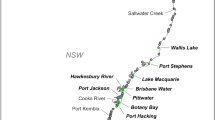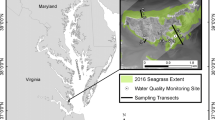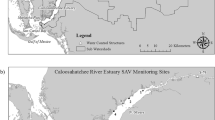Abstract
Historic changes in water-use management in the Florida Everglades have caused the quantity of freshwater inflow to Florida Bay to decline by approximately 60% while altering its timing and spatial distribution. Two consequences have been (1) increased salinity throughout the bay, including occurrences of hypersalinity, coupled with a decrease in salinity variability, and (2) change in benthic habitat structure. Restoration goals have been proposed to return the salinity climates (salinity and its variability) of Florida Bay to more estuarine conditions through changes in upstream water management, thereby returning seagrass species cover to a more historic state. To assess the potential for meeting those goals, we used two modeling approaches and long-term monitoring data. First, we applied the hydrological mass balance model FATHOM to predict salinity climate changes in sub-basins throughout the bay in response to a broad range of freshwater inflow from the Everglades. Second, because seagrass species exhibit different sensitivities to salinity climates, we used the FATHOM-modeled salinity climates as input to a statistical discriminant function model that associates eight seagrass community types with water quality variables including salinity, salinity variability, total organic carbon, total phosphorus, nitrate, and ammonium, as well as sediment depth and light reaching the benthos. Salinity climates in the western sub-basins bordering the Gulf of Mexico were insensitive to even the largest (5-fold) modeled increases in freshwater inflow. However, the north, northeastern, and eastern sub-basins were highly sensitive to freshwater inflow and responded to comparatively small increases with decreased salinity and increased salinity variability. The discriminant function model predicted increased occurrences of Halodule wrightii communities and decreased occurrences of Thalassia testudinum communities in response to the more estuarine salinity climates. The shift in community composition represents a return to the historically observed state and suggests that restoration goals for Florida Bay can be achieved through restoration of freshwater inflow from the Everglades.






Similar content being viewed by others
References
Armitage, A.R., T.A. Frankovitch, K.L. Heck Jr., and J.W. Fourqurean. 2005. Experimental nutrient enrichment causes complex changes in seagrass, microalgae, and macroalgae community structure in Florida Bay. Estuaries 28: 422–434.
Boyer, J.N., J.W. Fourqurean, and R.D. Jones. 1999. Seasonal and long-term trends in water quality of Florida Bay (1989–1997). Estuaries 22: 369–383.
Brewster-Wingard, G.L., and S.E. Ishman. 1999. Historical trends in salinity and substrate in central Florida Bay: A paleoecological reconstruction using modern analogue data. Estuaries and Coasts 22: 369–383.
Butler IV, M.J., J.H. Hunt, W.F. Herrnkind, M.J. Childress, R. Bertelsen, W. Sharp, T. Matthews, J.M. Field, and H.G. Marshall. 1995. Cascading disturbances in Florida Bay, USA: Cyanobacterial blooms, sponge mortality, and implications for juvenile spiny lobsters Panulirus argus. MEPS 129: 119–125.
Chester, A.J., and G.W. Thayer. 1990. Distribution of spotted seatrout (Cynoscion nebulosus) and gray snapper (Lutjanus griseus) juveniles in seagrass habitats of western Florida Bay. Bulletin of Marine Science 46: 345–357.
Clark, J.S., S.R. Carpenter, M. Barber, S. Collins, A. Dobson, J.A. Foley, D.M. Lodge, M. Pascual, R. Pielke Jr., C. Pringle, W.V. Reid, K.A. Rose, O. Sala, W.H. Schelesinger, D.H. Wall, and D. Wear. 2001. Ecological forecasts: An emerging imperative. Science 293: 657–660.
Cosby, B.J., W.K. Nuttle, and J.W. Fourqurean. 1999. FATHOM: Model description and initial application to Florida Bay, project completion report. Washington, D.C.: National Park Service, U.S. Dept. of Interior.
Cosby, B., W. Nuttle, and F. Marshall. 2005. FATHOM enhancements and implementation to support development of MFL for Florida Bay. Final report on contract C-C-15975-WO05-05 for the South Florida Water Management District. New Smyrna Beach: Environmental Consulting & Technology.
Fourqurean, J.W., and M.B. Robblee. 1999. Florida Bay: A history of recent ecological changes. Estuaries 22: 345–357.
Fourqurean, J.W., J.C. Zieman, and G.V.N. Powell. 1992. Phosphorus limitation of primary production in Florida Bay: Evidence from the C:N:P ratios of the dominant seagrass Thalassia testudinum. Limnology and Oceanography 37: 162–171.
Fourqurean, J.W., R.D. Jones, and J.C. Zieman. 1993. Processes influencing water column nutrient characteristics and phosphorus limitation of phytoplankton biomass in Florida Bay, FL, USA: Inferences from spatial distributions. Estuarine, Coastal and Shelf Science 36: 295–314.
Fourqurean, J.W., G.V.N. Powell, W.J. Kenworthy, and J.C. Zieman. 1995. The effects of long-term manipulation of nutrient supply on competition between the seagrasses Thalassia testudinum and Halodule wrightii in Florida Bay. Oikos 72: 349–358.
Fourqurean, J.W., J.N. Boyer, M.J. Durako, L.N. Hefty, and B.J. Peterson. 2003. Forecasting responses of seagrass distribution to changing water quality using monitoring data. Ecological Applications 13: 474–489.
Frankovich, T.A., A.R. Armitage, A.H. Wachnicka, E.E. Gaiser, and J.W. Fourqurean. 2009. Nutrient effects on seagrass epiphyte community structure in Florida Bay. Journal of Phycology 45: 1010–1020.
Hansen, M., and N.T. DeWitt. 2000. 1890 and 1990 bathymetry of Florida Bay. U.S. Geological Survey Open File Report 00-347.
Herbert, D.A., and J.W. Fourqurean. 2009. Phosphorus availability and salinity control productivity and demography of the seagrass Thalassia testudinum in Florida Bay. Estuaries and Coasts 32: 188–201.
Hittle, C., E. Patino, and M. Zucker. 2001. Freshwater flow from estuarine creeks into northeastern Florida Bay. U.S. Geological Survey Water-resources Investigations Report 01–4164. Tallahassee: U.S. Geological Survey.
Hobbie, J.E. 2000. Estuarine science: The key to progress in coastal ecological research. In Estuarine Science: A synthetic approach to research and practice, ed. J.E. Hobbie, 1–11. Washington, D.C.: Island.
Lee, T.N., E. Johns, N. Melo, R. Smith, P. Ortner, and D. Smith. 2006. On Florida Bay hypersalinity and water exchange. Bulletin of Marine Science 79: 301–327.
Light, S.S., and J.W. Dineen. 1994. Water control in the Everglades: A historical perspective. In Everglades: The ecosystem and its restoration, ed. S.M. Davis and J.C. Ogden, 47–84. Delray Beach: St. Lucie.
Lirman, D., and W.P. Cropper Jr. 2003. The influence of salinity on seagrass growth, survivorship, and distribution within Biscayne Bay, Florida: Field, experimental, and modeling studies. Estuaries 26: 131–141.
Nance, J.M. 1994. A biological review of the Tortugas pink shrimp fishery through December 1993. Galveston: Galveston Laboratory, Southeast Fisheries Science Center, National Marine Fisheries Service.
Nuttle, W.K., J.W. Fourqurean, B.J. Cosby, J.C. Zieman, and M.B. Robblee. 2000. Influence of net freshwater supply on salinity in Florida Bay. Water Resources Research 36: 1805–1822.
Perry, W.B. 2004. Elements of south Florida’s Everglades restoration plan. Ecotoxicology 13: 185–194.
Price, R.M., P.K. Swart, and J.W. Fourqurean. 2006. Coastal groundwater discharge—an additional source of phosphorus for the oligotrophic wetlands of the Everglades. Hydrobiologia 569: 23–36.
Quammen, M.L., and C.P. Onuf. 1993. Laguna Madre: Seagrass changes continue decades after salinity reduction. Estuaries 16: 302–310.
RECOVER. 2007. Final draft 2006 system status report, pilot assessment reports for the monitoring and assessment plan modules. Jacksonville: Restoration Coordination and Verification Team, U.S. Army Corps of Engineers, Jacksonville District.
RECOVER. 2008. Southern coastal systems salinity performance measure. Restoration Coordination and Verification Team, U.S. Army Corps of Engineers, Jacksonville District, Jacksonville. http://www.evergladesplan.org/pm/recover/recover_docs/perf_measures/090108_se_salinity.pdf. Accessed 10/30/09.
Robblee, M.B., T.R. Barber, P.R. Carlson, M.J. Durako, J.W. Fourqurean, L.K. Muehlstein, D. Porter, L.A. Yarbro, R.T. Zieman, and J.C. Zieman. 1991. Mass mortality of the tropical seagrass Thalassia testudinum in Florida Bay (USA). Marine Ecology Progress Series 71: 297–299.
Rudnick, D.T., Z. Chen, D.L. Childers, J.N. Boyer, and T.D. Fontaine III. 1999. Phosphorus and nitrogen inputs to Florida Bay: The importance of the Everglades watershed. Estuaries 22(2b): 398–416.
Schmidt, T.W. 1979. Ecological study of fishes and water quality in Florida Bay, Everglades National Park, Florida. RSP-EVER N-36. Homestead: South Florida Research Center, Everglades National Park.
Smith, T.J., H.H. Hudson, M.B. Robblee, G.V.N. Powell, and P.J. Isdale. 1989. Freshwater flow from the Everglades to Florida Bay: A historical reconstruction based on fluorescent banding in the coral Solenatrea Bournoni. Bulletin of Marine Science 44: 274–282.
Swart, P.K., G.F. Healy, R.E. Dodge, P. Kramer, J.H. Hudson, R.B. Halley, and M.B. Robblee. 1996. The stable oxygen and carbon isotopic record from a coral growing in Florida Bay: A 160 year record of climatic and anthropogenic influence. Paleogeography, Paleoclimatology, Paleoecology 123: 219–237.
Swart, P., G. Healy, L. Greer, M. Lutz, A. Saied, D. Anderegg, R. Dodge, and D. Rudnick. 1999. The use of proxy chemical records in coral skeletons to ascertain past environmental conditions in Florida Bay. Estuaries 22: 384–397.
Tabachnick, B.G., and L.S. Fidell. 2007. Using multivariate statistics, 5th ed. Boston: Allyn and Bacon.
Thayer, G.W., A.B. Powell, and D.E. Hoss. 1999. Composition of larval, juvenile, and small adult fishes relative to changes in environmental conditions in Florida Bay. Estuaries 22: 518–533.
US Army Corps of Engineers and South Florida Water Management District. 1999. Central and Southern Florida project comprehensive review study, final integrated feasibility report and programmatic environmental impact statement. Jacksonville: United States Army Corps of Engineers, Jacksonville District.
US Army Corps of Engineers and South Florida Water Management District. 2002. Florida Bay/Florida Keys feasibility study. United States Army Corps of Engineers, Jacksonville District, Jacksonville. http://www.evergladesplan.org/pm/studies/fl_bay.aspx#details. Accessed 11/9/09.
Williams, S.L. 1990. Experimental studies of Caribbean seagrass bed development. Ecological Monographs 60: 449–469.
Zieman, J.C. 1982. The ecology of the seagrasses of south Florida: A community profile. FWS/OBS-82/25. Washington, D.C.: U.S. Fish and Wildlife Service.
Zieman, J.C., J.W. Fourqurean, and R.L. Iverson. 1989. Distribution, abundance, and productivity of seagrasses and macroalgae in Florida Bay. Bulletin of Marine Science 44: 292–311.
Acknowledgments
The monitoring programs that supplied vital benthic habitat data for this effort included the South Florida Water Management District/Miami-Dade County Department of Environmental Resources Management funded monitoring program, the Florida Keys National Marine Sanctuary funded by grants from NOAA’s South Florida Program (contract NA06NOS4780105) and the US EPA (Assistance Agreement X797468102), and Florida Department of Environmental Protection’s Fish Habitat Assessment Program funded by Florida DEP, USGS Biological Resources Division, and Everglades National Park. Funding for analyses were provided by grants from Everglades National Park, Critical Ecosystems Studies Initiative (Cooperative agreement 1443CA528001022), and Florida Sea Grant (SI-08-33). Water quality data were made available by J.N. Boyer at Florida International University. Further support was provided by the National Science Foundation through the Florida Coastal Everglades Long-Term Ecological Research program under Grant No. DBI-0620409 and Grant No. DEB-9910514. This is publication number 514 from the Southeast Environmental Research Center at FIU.
Author information
Authors and Affiliations
Corresponding author
Appendices
Appendix 1
Apportionment of freshwater inflow to Florida Bay in FATHOM.
The total volume of freshwater running off the Florida mainland into Florida Bay was apportioned into the basins along the northeast boundary of Florida Bay using information derived from observed monthly creek discharges in the region (Hittle et al. 2001, Clinton Hittle, personal communication). Observed data were not available for all FATHOM basins receiving input, and the period of observed data did not cover the entire FATHOM simulation period. Two characteristics of the observed flow were used to establish the runoff distribution in FATHOM: (1) the total volume of freshwater flow over the observed period of record in the creeks with observed discharge was matched and (2) the fraction of total freshwater flow in each creek with observed discharge was matched. The resulting distribution of freshwater inputs to FATHOM basins along the northeast boundary was maintained under scenarios of increased freshwater runoff.
Name | FATHOM basin | Percent of total runoff |
Manatee Bay | 6 | 11.2 |
Long Sound | 7 | 12.5 |
Joe Bay | 13 | 12.5 |
Davis Cove | 12 | 36.6 |
Alligator Bay | 12 | 6.2 |
Little Madeira | 14 | 7.8 |
Terrapin Bay | 25 | 2.3 |
Madeira Bay | 24 | 2.1 |
Santini Bight | 35 | 3.4 |
Rankin Bight | 36 | 1.1 |
Garfield Bight | 37 | 4.3 |
Reference
Hittle, C, Patino, E, Zucker, M. 2001. Freshwater flow from estuarine creeks into northeastern Florida Bay. U.S. Geological Survey Water-resources Investigations Report 01–4164, Tallahassee, FL.
Appendix 2
Appendix 3
Rights and permissions
About this article
Cite this article
Herbert, D.A., Perry, W.B., Cosby, B.J. et al. Projected Reorganization of Florida Bay Seagrass Communities in Response to the Increased Freshwater Inflow of Everglades Restoration. Estuaries and Coasts 34, 973–992 (2011). https://doi.org/10.1007/s12237-011-9388-4
Received:
Revised:
Accepted:
Published:
Issue Date:
DOI: https://doi.org/10.1007/s12237-011-9388-4




